Despite not relying solely on water to breathe, turtles cannot live without water for long. However, the specific time in which your turtle can survive without water depends on the turtle species you own.
Obviously, as a turtle owner, you should be responsible enough to provide your turtle or turtles with water on a consistent basis. Nevertheless, knowing how long they can go without water is useful knowledge to equip yourself with.
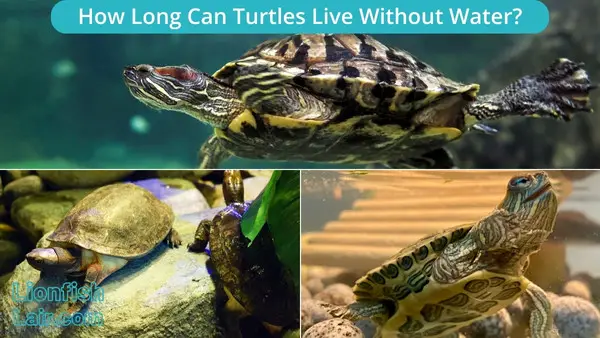
A healthy adult water turtle can live for roughly one week without drinking water and can survive for around one month outside of a water tank as long as they have access to drinking water.
The exception to this is box turtles. This species of water turtle can only live for 12 to 24 hours maximum without both drinking and water to reside in.
Why Does My Turtle Need Water?
Turtles not only need water for hydration, but they need it to help speed up their metabolism too. If your turtle lacks water, they will become dehydrated, weaker, and more prone to disease - all of these can easily result in death.
Just because turtles can live on both water and land doesn’t mean you should favor one or the other - they require access to both in order to live a healthy life.
Turtles are cold-blooded, meaning that they rely solely on their environment to determine their body temperature. Typically in the wild turtles will swim in the water to cool off when the temperature is too hot outside.
Turtle tank water temperatures need to be perfect and well-monitored because if it is too cold, turtles can easily become ill and the same applies if it is too hot.
The ideal tank temperature should be between 72-82°F (22°C-28°C). If you are acquiring fish for your turtle tank, you need to ensure both temperature requirements are compatible.
Below is a brief and general overview of water turtles and their requirements in a graphical format, hopefully you find this useful and can use as a reference:
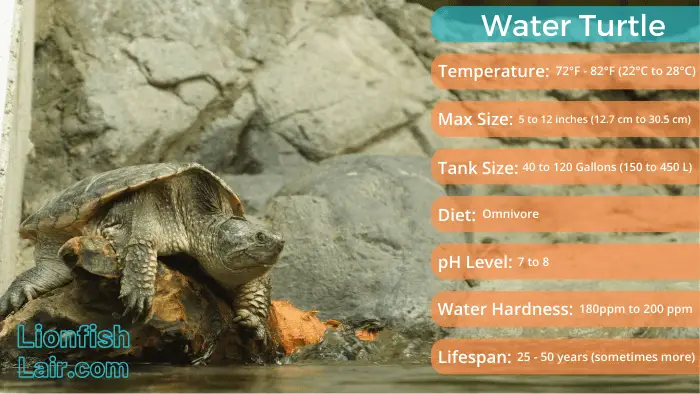
Key Factors That Determine How Long Can Turtles Go Without Water
Hydration from water is key to regulating their bodies. Turtle species, living conditions, and climate all play key roles in determining how long your turtle can survive without water.
Due to having robust, natural mechanisms in their bodies, most turtle species can survive for up to 7 days without water.
Below are the key factors in ensuring their survival and also why they might be spending time out of the water you provide them in their tanks.
Turtles Basking
The term basking, or “sunning” refers to your turtle drying out and absorbing essential nutrients from the sun.
Obviously, due to your turtle living in a tank, typically without access to direct sunlight, they will require a basking lamp, which, as a turtle owner, you should already have and know about.
Turtles typically need to bask for between 2 and 8 hours each day, during this time period they will not be drinking water. It is their natural instinct to not surpass 8 hours of sunning due to their bodies requiring water to drink.
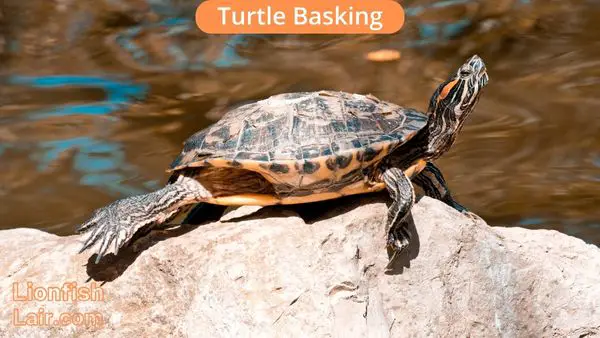
Basking is an essential part of turtles' routines as it regulates temperature and improves their metabolism health, as well as drying out their shells which in return, fends off harmful bacteria and infections from building up.
Despite basking being incredibly beneficial, turtles must return to water to bathe within 30 days due to their internal organs requiring hydration.
Not only this, but turtles are far more mobile in water, making exercise easier for them, which is additionally beneficial.
Age of your Turtle
The time in which your turtle can live without water is also dependent on their age - hatchlings and juveniles in captivity will only survive for a maximum of 5 days without water.
It is fairly obvious, but young turtles have not fully developed, making their bodies weaker in general, along with more sensitive immune systems, and not having the ability to store as much energy and fats.
Tank Temperature and Humidity
Another key factor in how long your turtle can survive without water is the temperature of your tank and the humidity of their environment.
The higher your temperature, the less time your turtle can live without water for.
Heat causes water stored in your turtle’s body to evaporate quickly. This is why water turtles need to consume water within a maximum of 7 days and box turtles 24 hours.
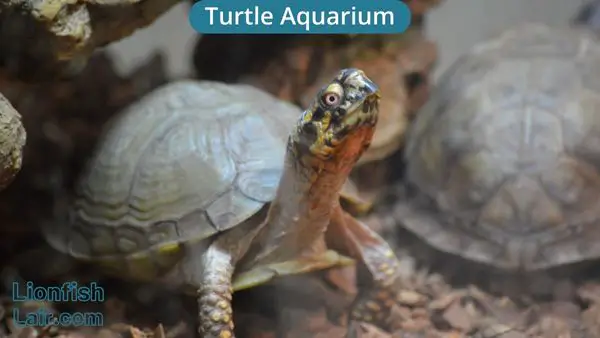
Due to this, you should also always have a body of water for your turtles to cool down in when temperatures are too high for them.
If your tank has a lot of humidity, this will also help them remain hydrated by absorbing the heavy moisture in the air.
Brumation of your Turtle
Brumation is in reference to the hibernation of your turtle, and all other reptiles for that matter. Hibernation is the process of slowing down their metabolism when they go into resting periods during cooler months, typically winter, in the wild.
Despite the fact that the environment you create for your turtle will be consistent and controlled, it is a good idea to inform yourself of the brumation process.
During their hibernation, your turtle’s breathing will significantly slow down, which in turn, causes their metabolism to slow down.
They will then use stored energy and take oxygen from water, which is why it is so important to keep your turtle in water for the duration.
Dehydrated Turtle Warning Signs
I have provided a brief checklist of symptoms that your turtle is dehydrated and needs water immediately:
- If your turtle is not eating properly, it is probably due to them not intaking enough water. They do not produce saliva nor do they have teeth, so, therefore require water to swallow and digest food.
- If you notice closed or sunken eyes on your turtle, ensure they are hydrated immediately, this is a telltale sign that they are dehydrated.
- Weight loss is common in severely dehydrated turtles as they store a lot of liquid in their tissues.
- Lack of muscle is also a sign of dehydration for your turtle.
- If they are walking or just generally behaving lethargically, then they are likely lacking water or this could be the sign of a more severe health problem.
How to Keep Your Turtle Hydrated
Below is another checklist, this time offering experienced advice on how to keep your turtle healthy and hydrated:
- Ensure your turtle’s tank has plenty of water in it for them to swim around in and use for drinking. The size of your tank and turtle will determine how many gallons of water you need, but the more, the better!
- I mention this a little further down the guide but dechlorinate tap water if that is your water of choice.
- Make sure that you are cleaning the tank regularly, including the water!
- Keep the tank temperature consistently between 72 and 82°F (22°C to 28°C).
- Check and replace the tank water on a regular basis (once or twice a week minimum).
How To Provide Fresh Water For Your Turtle
There are many hobbyists that use different methods when it comes to providing their turtles with healthy water.
Some use tap water, and while this is usually OK, some tap water contains more chlorine than others, and chlorine does not agree with turtles, often causing irritation.
Additionally, excess chlorine will destroy useful bacteria in your tank, which can interrupt the nitrogen cycle. By using a water conditioner you can easily dechlorinate your tap water before adding it to the tank.
You must also clean your tank regularly. Turtles spend a lot of time in water which typically results in the water becoming murky and unclean, which usually results in an unhealthy and potentially ill turtle.
Water filters are also a good idea if you have a turtle tank as they can produce a lot of waste, which is one of the many reasons why turtles are not compatible with goldfish since they produce a lot of waste too.
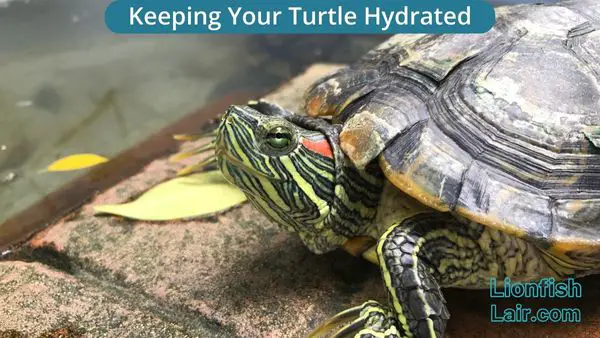
Which Turtle Species Make Good Pets?
Many turtle owners and enthusiasts would say that red-eared slider turtles, mud turtles, musk turtles, and painted turtles are the best species for beginners.
Something to always keep in mind when it comes to turtles is that they may start their lives small, but they can grow to some pretty big sizes, even outgrowing their tanks.
The turtles listed above are also semi-aquatic, meaning that they certainly require water and a good swimming area as well as a dry-land platform within your tank.
Conclusion
Turtles most certainly do need water to survive, but their length of survival depends on several factors.
Age, species, temperature, and more all play the roles in how long a pet turtle can survive without any water.
The main takeaway from this should be that providing your turtle with clean water consistently is of the utmost importance for your turtle's health and happiness.

